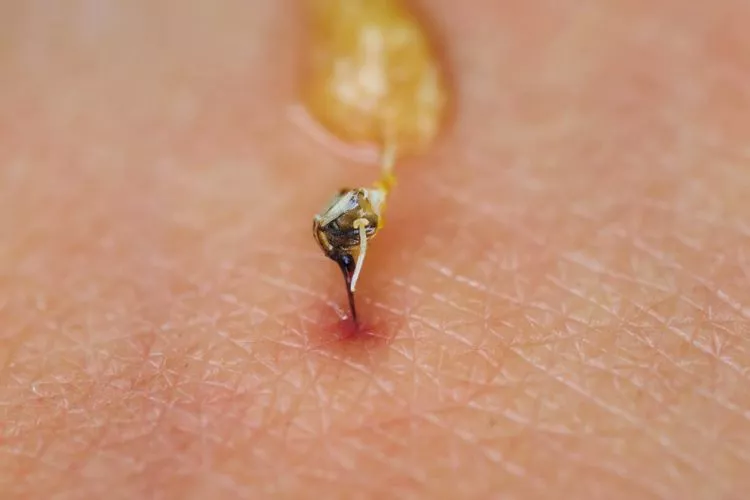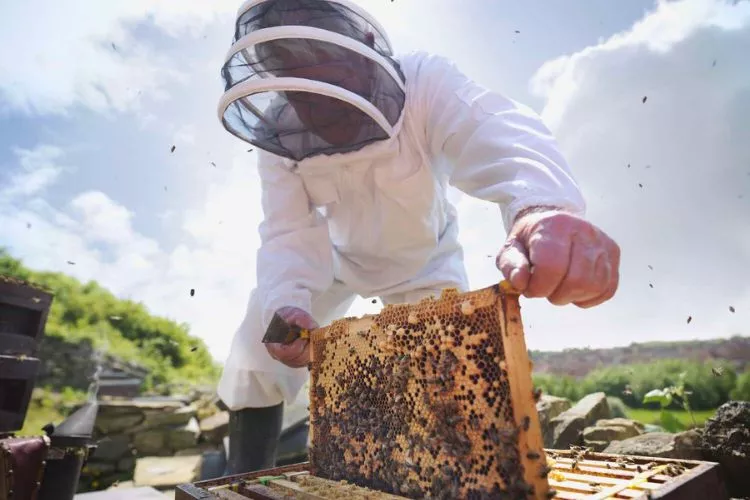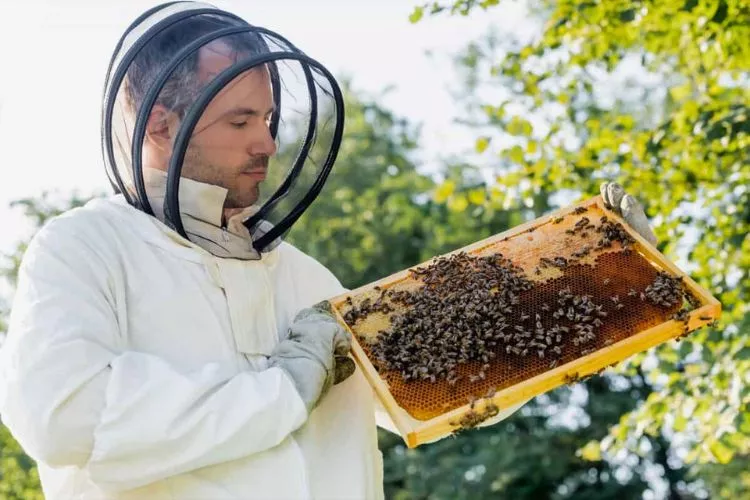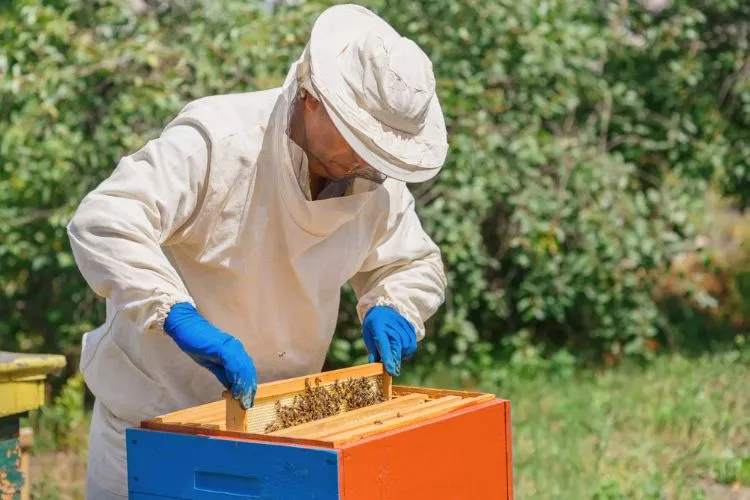Bees are insects that are well known for their role in pollination and honey-making. However, they also have a notoriety for their stings, which can be dangerous for those who are allergic to them.
That’s why it’s crucial to know what to wear when you’re working with bees to ensure you’re well-protected. But can bees sting through jeans? Let’s find out.

Can Bees Sting Through Jeans?
To answer this question, it’s essential to understand how bees’ stingers work. Bees have a stinger which is barbed. When a bee stings someone, the barbed stinger comes off and remains stuck in the skin, leading to the death of the bee. The honeybee is the only type of bee that loses its stinger when it stings a person or a predator.
Barbed stingers can stick to any material, but a study shows that the possibility of bee stingers penetrating through denim and other clothing materials is low.
Although jeans are not the most protective clothing for beekeepers and gardeners, they can offer some protection against bee stings.
The thickness and the tight weave of the denim fabric obstruct bees from penetrating through it. However, if a bee manages to find a way to the stinger without getting obstructed by the fabric, jeans won’t be much of a hindrance.
Clothing Materials to Avoid When Working with Bees
When it comes to selecting the right clothing to wear while working with bees, it’s essential to understand what materials to avoid.
While some materials may seem thick enough to protect against bee stings, they may not provide the necessary protection. Here are some clothing materials that you should avoid when working with bees:

Synthetic Materials
Synthetic materials like polyester, nylon, and spandex tend to attract bees. When bees land on these fabrics, their stingers can penetrate them quickly, even if the fabric seems thick.
This is because these fabrics can stretch, making it easier for the bee’s barbed stinger to penetrate the material and reach the skin. Additionally, bees are attracted to the smell of synthetic fabrics, which can make it harder to avoid getting stung.
Loose Clothing
Loose clothing is not recommended when working with bees due to their tendency to provide easy access to exposed skin.
Flowy or baggy clothes can potentially trap bees inside their folds and aggravate the situation. Loose clothing can also make it challenging to detect if there is a bee on your skin, making it harder to avoid getting stung.
When selecting clothing for beekeeping or gardening, it’s crucial to choose clothing that fits well and is not too loose or baggy. You want to ensure that you can move around freely, but also that there is not enough room for bees to enter the clothing.
Light-Colored Clothes
Bees are more attracted to lighter colors than darker ones. This is because they associate lighter colors with flowers and nectar.
Wearing light-colored clothes can attract bees to you, which can increase the likelihood of getting stung. Bright colors like yellow and white should be avoided, as they can resemble the colors of flowers, which attracts bees to those areas.
Instead, it’s recommended to wear darker colors like navy blue, brown, or black, as they can help you blend into the surrounding environment. This minimizes the likelihood of bees being attracted to your clothing while you’re working.
Other survival related article: Are Leeches Edible?
Choosing the Right Clothing for Beekeeping and Gardening
Now that you know what materials to avoid when working with bees, it’s essential to choose the right clothing to protect yourself against bee stings. When selecting clothing for beekeeping and gardening, here are some things to keep in mind:

Long-Sleeved Shirts/Pants
Long-sleeved shirts and pants that cover the arms and legs are a good choice when working with bees. They provide full coverage and prevent bees from coming into contact with your skin.
Cotton and other natural fibers are good options for these because they are comfortable and breathable, but also durable and provide good protection.
Thick and Sturdy Fabrics
Clothing materials like denim and canvas are known for their thickness and sturdiness. These materials are tight-knit and make it difficult for bees to penetrate through them.
These types of fabrics are good options for those who don’t want to invest in full beekeeping suits but still want to ensure that they are well-protected.
Protective Gear
Beekeeping suits, jackets, gloves, and veils provide the best protection when working with bees. These are specially designed to keep bees away from your skin while you’re working.
Beekeeping suits come in various styles and sizes and offer full coverage for maximum protection. You can choose one that fits well and suits your needs, whether you’re an experienced beekeeper or just starting.
When it comes to protecting yourself against bee stings, it’s essential to select the right clothing to wear when working with bees.
Avoiding synthetic fabrics, loose clothing, and light colors can minimize the likelihood of getting stung while working with bees. Instead, opt for thicker and sturdier materials like cotton, denim, or canvas for added protection.
You may also want to consider investing in beekeeping suits, jackets, gloves, and veils to provide maximum coverage for those who work with bees regularly. Through proper clothing selection, you can ensure that you are safe and protected while working with bees.
What to Wear When Working with Bees?
When working with bees, it’s always best to dress up in protective gear. Here are some options to consider:

- Beekeeping Suits: Beekeeping suits are specially designed to provide protection from bee stings. They cover the entire body, including the head and face.
- Protective Jackets: A protective jacket is another option that can provide some protection to the upper body and arms. It’s crucial to choose one that is made up of thick and durable material.
- Gloves: Beekeeping gloves cover hands and wrists to provide protection against bee stings. Thick gloves are more appropriate as they offer better protection and greater dexterity.
- Hats and Veils: Hats with veils can protect the head and face from bee stings. They come in different styles and sizes, but it’s essential to choose the one that fits well and provides complete coverage.
Pro Tips for Choosing Beekeeping Gear
When selecting the most appropriate beekeeping gear for you, consider the following:
- Comfort: Choose protective gear made of lightweight and breathable materials for increased comfort and ease of movement.
- Quality: Invest in good quality protective gear that will last for years, and is well-designed to offer the best possible protection.
- Durability: Protective gear should be made of durable materials that can withstand repeated use, washing, and wear and tear.
- Fit: Ensure that beekeeping gear fits well and is not too tight or too loose.
Conclusion:
Can bees sting through jeans? While jeans might not be the best protection against bee stings, they do offer some level of protection. It’s crucial to remember that choosing the right clothing and protective gear when working with bees is essential to avoid potential hazards.
Protect yourself and stay safe by investing in well-designed and durable protective gear. Now that you know what to wear, you’re ready to work with bees like a pro!


